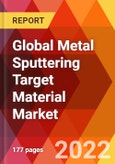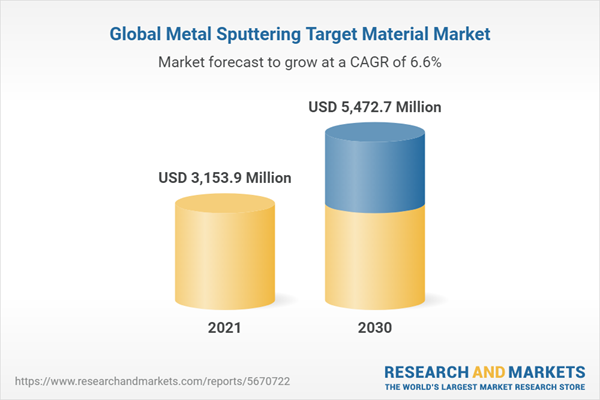As per the latest report, the global metal sputtering target market volume was pegged at 1,39,214 metric tons in 2021 and is projected to grow at a CAGR of 6.19% in the years to come.
From the last few years, there has been a growing demand for metal sputtering target material, as it is a fast and clean process for producing thin films. Metal sputtering also offers attractive options for synthesis of high-quality films with tailored properties. Wherein, Copper is one of the most commonly used metals for sputtering targets, due to its high electrical conductivity and ability to form very small defects. Materials used for sputtering can include plastics and other polymers, zinc, aluminum, magnesium, and tin.
Investments in metal sputtering technology are booming, as materials scientists and engineers explore new ways to produce fine, high-quality texture films and particles. One such material is nickel-titanium alloy (NiTi), which has exceptional mechanical properties and can be used to fabricate aircraft parts, among other applications.
In today's market, there are many factors driving demand for metal sputtering target material. Some of the key drivers of demand include the increasing popularity of 3D printing, the need for customized materials, and the demands of research and development. In addition to this, rapid expansion of the semiconductor and MEMS industries, the increasing popularity of nanoscience and nanotechnology research, and the increased importance of metal-air plasma deposition (MAPD) for production of thin films are driving the global metal sputtering target material market growth.
Market Dynamics of Global Sputtering Target Material Market
Drivers
- Ever-growing semiconductor industry is one of the main drivers of demand for metal sputtering targets. As of 2021, the global semiconductor market is valued at over $526.8 billion and is projected to grow at a CAGR of over 13.3% in the years to come. As a result, there is a high demand among semiconductor manufacturers for an ultra-pure, highly homogeneous film on their wafers, and sputtering is one of the most effective ways to achieve this. Wherein, metal sputtering targets are often used to create these films.
- Growing demand for metal sputtering target materials in solar cells and other energy applications. In order to be efficient, solar cells need to have a very smooth surface with few defects. Sputter deposition is an ideal way to create such a surface, and so metal sputter targets are in high demand for this application.
- The optical properties of thin films created by sputter deposition can be superior to those of thicker films deposited by other methods, making metal sputter targets increasingly attractive for optoelectronic applications such as light-emitting diodes (LEDs).
Restraints
Metal sputtering is a chemical vapor deposition process that uses metal atoms to create thin films and Nanostructures. Metal sputtering is an expensive technique and there are many factors that restrain the demand for metal sputtering.The following are the top 5 factors that restrain the demand for metal sputtering target material market:
- High capital outlay requirements
- Specialty needs for different materials
- Technical limitations
- Cost of consumables
- Easily availability of counterfeit products supply
Segment Overview
Global metal sputtering target materials market is segmented by type, application, and region.By Type
- Pure Metal
- Alloy
By Application
- Semiconductor
- Solar Energy
- Flat Panel Display
By Region
By region, the market is categorized into North America, Europe, Asia Pacific, Middle East and Africa, and Latin America. Wherein, Asia Pacific is expected to continue dominating the global metal sputtering target market with market share of more than 45%. Our research also suggest that the region is expected to exhibit fastest growth at a CAGR of over 7% during the forecast period, 2022-2030. China is the top performer in this area, accounting for almost one-third of all target material produced. The main drivers of this growth are likely to be increasing demand from the electronics and optoelectronics industries in China and Japan, as well as increasing demand from the aerospace and defense sectors in countries such as India and South Korea.However, Asia Pacific’s dominance is set to change in the near future as European countries are planning to ramp up their production.
Competitive Landscape
Some of the major players in the global metal sputtering target material market are JX Nippon Mining and Metals Corporation, Praxair, Plansee SE, Mitsui Mining and Smelting, Hitachi Metals, Honeywell, Sumitomo Chemical, Materion (Heraeus), GRIKIN Advanced Material Co. Ltd., LuvataVeolia Water Technologies, TOSOH, Advantec, among others.As per our market study, top 5 players are currently holding more than 60% market share. Smaller companies are entering the metal sputtering target materials market as the technology continues to evolve. By specializing in certain types of targets, these companies can capitalize on the growing interest in metal-based fabrication. Some of the smaller competitors are focusing on nanoscale targets, whereas others are catering to more traditional applications.
The biggest players in the metal sputtering target materials market are primarily large conglomerates that have a presence in many different industries. They are able to bring a wide range of resources and technologies to bear on their products, giving them an edge over their smaller competitors. This makes it challenging for small businesses to break into this market, which is why they are increasingly focusing on niche applications.
Global Metal Sputtering Target Materials Market Report Provides Insights on the Below Pointers:
- Market Penetration: Provides comprehensive information on the market offered by the prominent players
- Market Development: The report offers detailed information about lucrative emerging markets and analyzes penetration across mature segments of the markets
- Market Diversification: Provides in-depth information about untapped geographies, recent developments, and investments
- Competitive Landscape Assessment: Mergers & acquisitions, certifications, product launches in the global Metal Sputtering Target Materials Market have been provided in this research report. In addition, the report also emphasizes the SWOT analysis of the leading players.
- Product Development & Innovation: The report provides intelligent insights on future technologies, R&D activities, and breakthrough product developments
- The report also includes price margin analysis (labor, material, permit, tax), adoption analysis of green technologies, and adoption analysis of public vs private transport
- COVID-19 impact assessment on the market growth trend is also provided in the report
Global Metal Sputtering Target Materials Market Report Answers Questions Such As:
- What is the market size and forecast of the Global Metal Sputtering Target Materials Market?
- What are the inhibiting factors and impact of COVID-19 on the Global Metal Sputtering Target Materials Market during the assessment period?
- Which are the products/segments/applications/areas to invest in over the assessment period in the Global Metal Sputtering Target Materials Market?
- What is the competitive strategic window for opportunities in the Global Metal Sputtering Target Materials Market?
- What are the technology trends and regulatory frameworks in the Global Metal Sputtering Target Materials Market?
- What is the market share of the leading players in the Global Metal Sputtering Target Materials Market?
- What modes and strategic moves are considered favorable for entering the Global Metal Sputtering Target Materials Market?
Table of Contents
Companies Mentioned (Partial List)
A selection of companies mentioned in this report includes, but is not limited to:
- Plansee SE
- Mitsui Mining & Smelting
- Hitachi Metals
- Honeywell
- Sumitomo Chemical
- ULVAC
- Materion (Heraeus)
- GRIKIN Advanced Material Co., Ltd.
- TOSOH
- Ningbo Jiangfeng
- Heesung
- Luvata
- Fujian Acetron New Materials Co., Ltd
- Changzhou Sujing Electronic Material
- Luoyang Sifon Electronic Materials
- FURAYA Metals Co., Ltd
- Advantec
- Angstrom Sciences
- Umicore Thin Film Products
Table Information
| Report Attribute | Details |
|---|---|
| No. of Pages | 177 |
| Published | September 2022 |
| Forecast Period | 2021 - 2030 |
| Estimated Market Value ( USD | $ 3153.9 Million |
| Forecasted Market Value ( USD | $ 5472.7 Million |
| Compound Annual Growth Rate | 6.5% |
| Regions Covered | Global |









